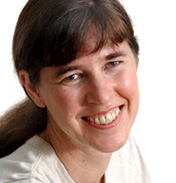Have you seen that film going around about the neurologist who had a stroke? Jill Bolte Taylor vividly describes her experiences as her left brain gradually stops working. See it here.
It’s amazing and inspiring. The experiences she has when her left logical, language-using, linear brain fails are like spiritual experiences. She feels expansive, connected and at one with everything in the universe. She feels incredible bliss as she revels in the present moment.
She is so moved by these experiences that she is motivated to share them with the world for one primary purpose: so that all of us can also experience that blissful place that is available to us all through the perception of our right brains.
Afterall, she realizes that the way the right brain sees the world is just as valid as the left brain’s perspective. Both viewpoints are required to have a full experience of life. And yet most of us are completely immersed in the left brain’s practical view of past and future, specifics, and separation. That right brain perspective is just what the world needs more of now, in order to fully understand how we are all inter-connected, inter-dependent and safe.
Her description of this other way of viewing the world is certainly inspiring. But she gives very little insight into how to actually do this …short of having a stroke ourselves which I’m sure she does NOT recommend.
So how do you reduce the activity of your left brain so that you can benefit from the holistic perspective of your right brain?
Of course, meditation is one proven way and the benefits are well-documented. I highly recommend it. But nonetheless it is difficult for busy people to find time to be completely quiet and undisturbed in order to meditate.
So I recommend instead another simple trick you can do in any spare moments when you are walking around, traveling or briefly at rest. This method comes from yoga and is also explained in Neuro-linguistic Programming (NLP).
Start with ‘soft eyes’. In other words, look at an object and soften your focus so that your gaze is broader. You will be able to see things far to both sides of your field of vision without moving your eyes or your head. Next, practice shifting your attention from the object in the centre, to the periphery of your vision. Notice that you can shift your attention back and forth, from the centre, to the periphery, without moving your eyes at all. You can even shift your attention to areas that you cannot see. Can you evenly distribute your attention to all directions around you?
As you practice this, notice how it feels. You may feel that the quality of your attention is very different when it is spread out around you than when it is focused, as in our usual every-day experiences. Can you feel the difference? That is the right side of your brain.
Studies in NLP have shown that the eyes and the mind are interconnected so that eye movements can be used to predict and control mind activities. So use your eyes to help you broaden your focus. Practice broadening your attention. You will learn new ways to see the world. You will feel bliss.
Have you seen that film going around about the neurologist who had a stroke? Jill Bolte Taylor vividly describes her experiences as her left brain gradually stops working. See it here.
It’s amazing and inspiring. The experiences she has when her left, logical, language-using, linear brain fails are like spiritual experiences. She feels expansive, connected and at one with everything in the universe. She feels incredible bliss as she revels in the present moment.
She is so moved by these experiences that she is motivated to share them with the world for one primary purpose: so that all of us can also experience that blissful place that is available to us all through the perception of our right brains.
Afterall, she realizes that the way the right brain sees the world is just as valid as the left brain’s perspective. Both viewpoints are required to have a full experience of life. And yet most of us are completely immersed in the left brain’s practical view of past and future, specifics, and separation. That right brain perspective is just what the world needs more of now, in order to fully understand how we are all inter-connected, inter-dependent and safe.
Her description of this other way of viewing the world is certainly inspiring. But she gives very little insight into how to actually do this …short of having a stroke ourselves which I’m sure she does NOT recommend.
So how do you reduce the activity of your left brain so that you can benefit from the holistic perspective of your right brain?
Of course, meditation is one proven way and the benefits are well-documented. I highly recommend it. But nonetheless it is difficult for busy people to find time to be completely quiet and undisturbed in order to meditate.
So I recommend instead another simple trick you can do in any spare moments when you are walking around, traveling or briefly at rest. This method comes from yoga and is also explained in Neuro-linguistic Programming (NLP).
Start with ‘soft eyes’. In other words, look at an object and soften your focus so that your gaze is broader. You will be able to see things far to both sides of your field of vision without moving your eyes or your head. Next, practice shifting your attention from the object in the centre, to the periphery of your vision. Notice that you can shift your attention back and forth, from the centre, to the periphery, without moving your eyes at all. You can even shift your attention to areas that you cannot see. Can you evenly distribute your attention to all directions around you?
As you practice this, notice how it feels. You may feel that the quality of your attention is very different when it is spread out around you than when it is focused, as in our usual every-day experiences. Can you feel the difference? That is the right side of your brain.
Studies in NLP have shown that the eyes and the mind are interconnected so that eye movements can be used to predict and control mind activities. So use your eyes to help you broaden your focus. Practice broadening your attention. You will learn new ways to see the world. You will feel bliss.




Hm. Interesting. I was only browsing and I come across this…. It’s ….. Interesting. As I said.
Did you try the eye exercises, Smith?